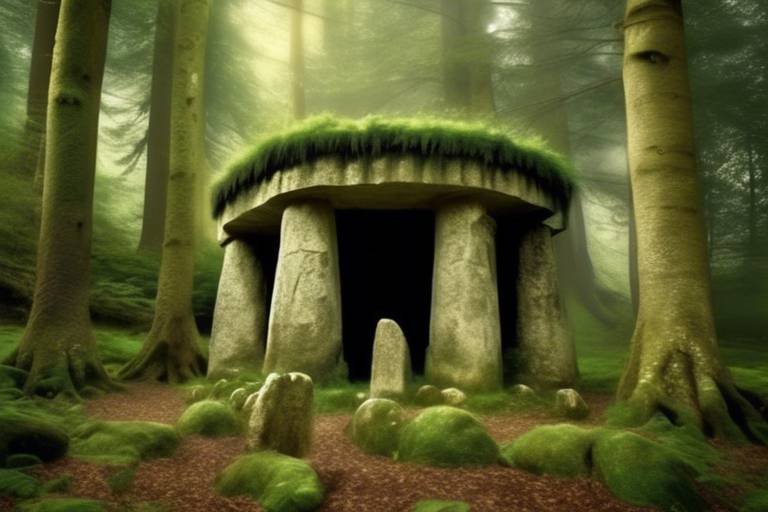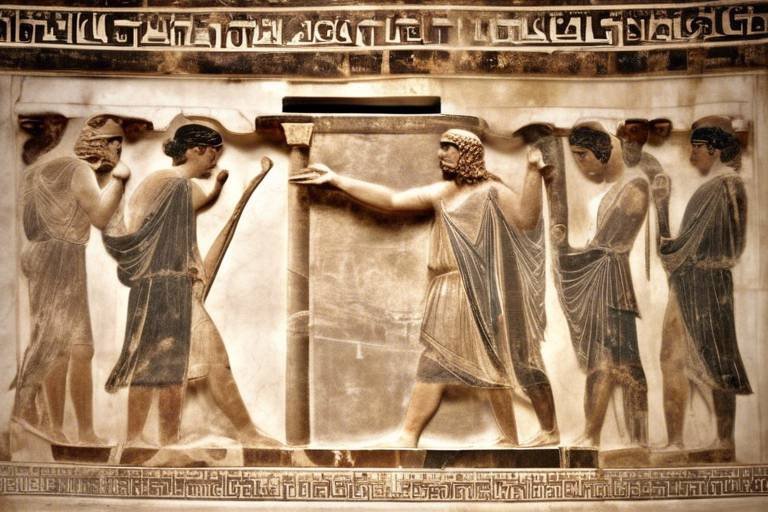The Mystery of the Ancient Cretan Civilization
Deep in the heart of the Mediterranean lies the captivating island of Crete, shrouded in the enigmatic veil of the ancient Minoan civilization. This remarkable civilization, known for its advanced culture and the legendary labyrinth of Knossos, continues to intrigue historians and archaeologists alike with its mysteries and sudden disappearance from the annals of history.

Origins of the Minoans
The origins of the Minoans, the ancient civilization of Crete, are shrouded in mystery and intrigue. Dating back to the Bronze Age, the Minoans flourished on the island of Crete, developing a unique culture that captivates historians and archaeologists to this day. Their society was characterized by advanced urban planning, sophisticated artistry, and a complex social structure that set them apart from their contemporaries.
One of the defining features of the Minoan civilization was their intricate language, known as Linear A, which remains undeciphered to this day. This enigmatic script adds to the allure of the Minoans, leaving scholars to speculate about the content of their writings and the depth of their intellectual pursuits.
Interactions with neighboring cultures in the Bronze Age Aegean, such as the Mycenaeans and Egyptians, played a significant role in shaping the Minoan society. Through trade and diplomatic relations, the Minoans established themselves as a dominant force in the region, influencing art, architecture, and religious practices across the Mediterranean.
As we delve deeper into the origins of the Minoans, we uncover a civilization that was not only advanced for its time but also deeply connected to the natural world. Their reverence for nature, reflected in their art and religious beliefs, speaks to a profound understanding of the environment and its significance in shaping human existence.

Palace of Knossos
The Palace of Knossos stands as a testament to the grandeur and sophistication of the Minoan civilization. Located near modern-day Heraklion in Crete, this magnificent structure served as the political, administrative, and cultural hub of Minoan society. The palace's design, characterized by a labyrinthine layout, advanced plumbing systems, and multi-story construction, showcases the architectural ingenuity of the Minoans.
One of the most striking features of the Palace of Knossos is its vibrant frescoes that adorn the walls, depicting scenes from everyday life, mythological tales, and religious ceremonies. These colorful artworks provide valuable insights into Minoan culture, showcasing their reverence for nature, animals, and rituals.
The palace's strategic location allowed it to control trade routes and oversee maritime activities, highlighting the Minoans' economic prowess and influence in the Aegean region. The intricate design of the palace, with its interconnected courtyards, storerooms, and living quarters, reflects a society that valued both functionality and aesthetics.
Excavations at the site have revealed a complex network of rooms and corridors, some of which are believed to have served specific purposes such as storage, workshops, and ceremonial spaces. The presence of advanced plumbing systems, including clay pipes for water management, showcases the Minoans' engineering expertise.
The Palace of Knossos also holds a place in Greek mythology, with legends suggesting that it was the setting for the myth of the Minotaur and the Labyrinth. While the historical accuracy of these tales is debated, they add an air of mystery and intrigue to the already enigmatic civilization of the Minoans.

Minoan Art and Culture
The Minoan civilization is renowned for its rich artistic expression and vibrant culture, which offer a fascinating glimpse into their way of life. The art of the Minoans is characterized by intricate designs and vivid colors, reflecting their connection to nature and religious beliefs. One of the most iconic aspects of Minoan art is their exquisite pottery, adorned with intricate patterns and motifs that showcase their craftsmanship and attention to detail. These pottery pieces not only served practical purposes but also held symbolic significance in religious rituals and daily life.
Furthermore, Minoan jewelry is a testament to their advanced craftsmanship and artistic flair. Intricate gold and silver pieces, often featuring motifs inspired by nature and mythology, highlight the Minoans' skill in metalworking and their appreciation for beauty and adornment. These pieces not only served as personal ornaments but also symbolized social status and religious significance within Minoan society.
Religious rituals played a significant role in Minoan culture, with bull-leaping being a prominent and mysterious practice depicted in their art. The bull, symbolizing power and fertility, was central to Minoan religious beliefs, and the daring acrobatics of bull-leaping were likely part of sacred ceremonies and rituals. The depictions of bull-leaping in Minoan art suggest a deep connection between the physical and spiritual realms, emphasizing the importance of courage and agility in their religious practices.
Moreover, the Minoans' frescoes, such as the famous "Prince of the Lilies" and "Dolphin Fresco," provide a window into their artistic sophistication and storytelling prowess. These colorful wall paintings, found in the Palace of Knossos and other Minoan sites, depict scenes from daily life, mythological narratives, and religious ceremonies. The intricate details and vibrant colors of these frescoes showcase the Minoans' mastery of artistic techniques and their ability to capture the essence of their culture and beliefs.

Trade and Influence
The Minoan civilization, known for its advanced seafaring skills and strategic location in the Aegean Sea, developed extensive trade networks that influenced the Mediterranean region during the Bronze Age. Through their maritime power, the Minoans established connections with various cultures, exchanging goods such as olive oil, wine, pottery, and luxury items like ivory and precious metals.
One of the key trade hubs of the Minoans was the bustling port city of Akrotiri on the island of Thera (modern-day Santorini), where evidence of their commercial activities has been unearthed through archaeological excavations. The Minoans' trade prowess not only enriched their own civilization but also played a significant role in shaping the economic landscape of the ancient world.
Furthermore, the Minoans' influence extended beyond trade, impacting the artistic and architectural styles of neighboring societies. Their vibrant frescoes, intricate pottery designs, and innovative building techniques inspired and influenced the artistic production of mainland Greece and other cultures in the Mediterranean region.
By dominating the sea routes and engaging in far-reaching trade, the Minoans not only accumulated wealth but also spread their cultural influence far and wide. Their legacy in trade and commerce continues to fascinate historians and archaeologists, offering valuable insights into the interconnected nature of ancient civilizations.

Religious Beliefs and Practices
The religious beliefs and practices of the Minoans offer a fascinating glimpse into their spiritual world, steeped in reverence for nature and deities. At the heart of Minoan religion was the worship of various nature gods and goddesses, symbolizing the forces of fertility, growth, and renewal. The Minoans held sacred rituals in honor of these deities, often conducted by priestesses who played a central role in their religious ceremonies.
Central to Minoan religious practices was the belief in the interconnectedness of the natural world and the divine. They adorned their sanctuaries with vibrant frescoes depicting ritual scenes, sacred symbols, and mythical creatures, reflecting their deep spiritual connection with the environment. The bull, a symbol of strength and power, held particular significance in Minoan culture, as evidenced by the ritualistic practice of bull-leaping.
The Minoans also venerated fertility goddesses, such as the iconic Snake Goddess, who embodied the nurturing and life-giving aspects of the divine feminine. These goddess figures, often depicted with serpents in hand, represented the cycle of birth, growth, and regeneration, underscoring the Minoans' profound respect for the life-giving forces of the earth.
Ritual ceremonies, including processions, offerings, and dances, were integral to Minoan religious life, fostering community cohesion and spiritual harmony. The Minoans believed in the power of rituals to appease the gods, ensure bountiful harvests, and maintain the balance between the earthly realm and the divine order.

Decline and Disappearance
The decline and disappearance of the Minoan civilization have long intrigued historians and archaeologists, shrouded in mystery and speculation. One of the prevailing theories suggests that a cataclysmic event, such as a volcanic eruption on the nearby island of Thera (modern-day Santorini), may have triggered a series of tsunamis that devastated Crete and led to the downfall of the Minoans. The archaeological evidence of widespread destruction and layers of volcanic ash supports this theory, indicating a sudden and dramatic end to their flourishing civilization.
Another hypothesis proposes that the Minoans fell victim to invasion and conquest, possibly by the Mycenaeans or other aggressive powers in the region. The presence of fortifications and signs of warfare in some Minoan sites hint at violent conflicts that could have weakened their society and paved the way for external domination. This theory suggests a more gradual decline, marked by warfare and political instability, eventually culminating in the assimilation or destruction of the Minoan culture.
Moreover, the myth of Atlantis, as recounted by Plato, has sparked speculation about a potential connection to the Minoans. Some researchers propose that the legendary island of Atlantis could have been inspired by the advanced civilization of ancient Crete, with its sophisticated architecture, maritime prowess, and enigmatic disappearance. While the Atlantis theory remains largely speculative, it adds a layer of intrigue to the enduring enigma of the Minoans.
Despite the various theories surrounding their decline, the ultimate fate of the Minoans remains a subject of debate and fascination. The abrupt end of their civilization, whether due to natural disasters, invasions, or other factors, has left a legacy of unanswered questions and a sense of awe at the sudden and mysterious disappearance of a once-thriving culture.

Archaeological Discoveries
Archaeological excavations in Crete have unearthed a treasure trove of artifacts and structures that offer valuable insights into the mysterious world of the ancient Minoans. Among the most significant discoveries are the elaborate palaces that served as the political, administrative, and religious centers of Minoan society. These palaces, such as the renowned Palace of Knossos, showcase the advanced architectural skills and artistic achievements of the Minoans.
One of the remarkable findings is the intricate frescoes adorning the walls of these palaces, depicting scenes from daily life, nature, and mythology. These vivid artworks provide a glimpse into the aesthetic preferences and storytelling traditions of the Minoans, offering clues about their beliefs and cultural practices.
Moreover, the discovery of sophisticated drainage systems, multi-story buildings, and complex urban planning in Minoan settlements highlights their advanced engineering and organizational capabilities. The meticulous attention to detail in the construction of their cities and palaces indicates a high level of societal organization and craftsmanship.
Archaeologists have also uncovered a wealth of artifacts, including intricately crafted pottery, exquisite jewelry, and religious objects that shed light on the material culture and artistic sophistication of the Minoans. These artifacts not only serve as decorative items but also reveal the symbolic meanings and cultural significance attached to various objects in Minoan society.
Furthermore, the excavation of burial sites and religious sanctuaries has provided valuable insights into the spiritual beliefs and funerary practices of the Minoans. The presence of elaborate tombs, ritual offerings, and sacred symbols suggests a deep connection to the natural world and a complex system of religious beliefs centered around fertility, rebirth, and the afterlife.
In addition to physical remains, the decipherment of Linear A and Linear B scripts found on clay tablets has offered a glimpse into the written language and administrative practices of the Minoans. These inscriptions provide valuable information about economic transactions, social structures, and religious activities, allowing researchers to piece together the intricate tapestry of Minoan society.

Legacy of the Minoans
The legacy of the Minoans continues to captivate historians, archaeologists, and art enthusiasts alike. Their influence reverberates through the annals of history, leaving an indelible mark on the world of art, architecture, and culture. The Minoans' innovative architectural designs, such as the intricate layout of the Palace of Knossos, have inspired generations of architects and designers.
Moreover, the Minoans' artistic achievements, from their vibrant frescoes depicting scenes of everyday life to their exquisite pottery and intricate jewelry, showcase a level of sophistication and creativity that was truly ahead of its time. Their artistic legacy serves as a testament to their ingenuity and artistic prowess, setting a standard for craftsmanship that has endured through the ages.
Furthermore, the Minoans' religious beliefs and practices, centered around nature worship and fertility goddesses, have influenced spiritual traditions across various cultures. The sacred rituals and the role of priestesses in Minoan society offer a glimpse into a world where spirituality and nature were intricately intertwined, shaping the way we perceive ancient religious practices.
Despite their sudden disappearance from the historical record, the Minoans' legacy lives on through the archaeological discoveries that continue to shed light on their enigmatic civilization. The ongoing excavations and research efforts unveil new insights into their society, providing a window into a civilization that thrived in the midst of the Bronze Age.
In conclusion, the legacy of the Minoans serves as a testament to the enduring impact of this ancient civilization on the course of history. Their art, architecture, and cultural practices have left an indelible mark on the world, sparking curiosity and fascination among those who seek to unravel the mysteries of ancient Crete.
Frequently Asked Questions
- What is the significance of the Minoan civilization?
The Minoan civilization, known for its advanced culture and artistry, holds significance in the history of ancient civilizations for its innovative architectural designs, vibrant artistic expressions, and mysterious disappearance that continues to intrigue scholars and enthusiasts alike.
- Where is the Palace of Knossos located?
The Palace of Knossos, the central hub of Minoan civilization, is located on the island of Crete in Greece. It is renowned for its intricate layout, advanced infrastructure, and colorful frescoes that provide insights into the daily life and mythological beliefs of the Minoan people.
- What are some key features of Minoan art and culture?
Minoan art and culture are characterized by exquisite pottery, intricate jewelry, and the practice of bull-leaping, a significant ritual in their society. Their vibrant artistic expressions reflect a deep connection to nature, religious beliefs, and social customs.
- How did the Minoans influence ancient civilizations?
The Minoans had extensive trade networks that influenced Mediterranean commerce and contributed to the development of ancient civilizations. Their maritime power, artistic innovations, and religious practices left a lasting impact on subsequent cultures in the region.
- What led to the decline and disappearance of the Minoan civilization?
Theories surrounding the decline of the Minoan civilization range from natural disasters like volcanic eruptions to invasion theories and even connections to the mythical tale of Atlantis. The sudden disappearance of the Minoans remains a subject of ongoing archaeological debate and speculation.



















